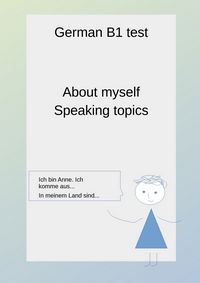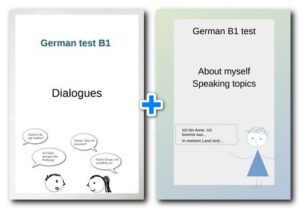Last Updated on February 23, 2024
Having dealt with letters examples and dialogue topics for b1 test, we move on to the next topic – German picture description phrases for DTZ. The picture description is called Bildbeschreibung. This task is used in the exam up to level B1, then something more substantial is usually used, like a diagram or graph.
Oral part of the German B1 exam. Speaking topics
All b1 German speaking topics (DTZ, telc b1). Part 2
Read about German writing examples B1 level test Deutschtest für Zuwanderer (DTZ).
Letters 1, Letters 2, Letters 3, Letters 4, Letters 5, Letters 6
Dialogues for B1 test 1, Dialogues 2
About myself in German – sich vorstellen
Everything about the #Orientierungstest (Test Leben in Deutschland) is here.
In the Deutsch-Test für Zuwanderer (DTZ) exam, the picture had to be described after the story about yourself and before the dialogue. Recently it was changed to speaking topics based on a picture. It is called “Über Erfahrungen sprechen (Aufgabeblatt mit Bildimpuls)”. No time is given for preparation.
I advise you to still look through this topic with basic phrases, vocabulary and sequence in case you still need a description of the picture, and then move on to the speaking topics that the people have had on the exam in the last 10 years.
Oral part of the German B1 exam. Speaking topics
All b1 German speaking topics (DTZ, telc b1). Part 2
German picture description b1
As a rule, your story will consist of:
– descriptions of what you see
– descriptions of your emotions, experiences or thoughts about it
– answering the examiner’s question about how things are with this topic in your home country, in Germany or in your family
The classical description should follow the logic of the depicted and be carried out from the main to the details in the sequence that the author of the picture suggests – after all, he does not choose the angle in vain. The sequence can be left to right, top to bottom, or front to back.
But we only care about the description from the general to the particular, because at level B1 it is too difficult for you to tell about all details. So you begin with general and there is a possibility that the description will be interrupted before you have to move on to the details.
The first thing you should suggest when looking at a picture is the theme. Based on the topic, you first describe what is important for this topic, and leave all other details behind the scenes.
For example, you see two people cooking in the kitchen. You decide that your topic is family or relationships. So, you have to say that you see two people in the kitchen, guess who they are to each other, describe what they do, using only those objects with which these people act. If they are cooking in a pot, then the shape and color of the table in the background is not important, as are other windows, curtains, cabinets and chairs. What matters is the pot and what’s in it (as you assume or see).
Only after that you can describe in a little more detail – so much the dictionary you have. But if nothing else comes to mind, it’s better don’t stumble or be silent, but immediately proceed to the development of the picture theme.
You can buy all b1 topics as pdf-file for 7 euros.
Write please your Email and “Topics EN”.
If you forgot to write email, you can write it in a comment-form.
You can also try a automatic payment.
After payment you receive a link for download.

speaking topics + about myself
+ picture description
+ German dialogues
for 10 euros.
Write please your Email and
“Topics + dialogues EN”
You can also try a automatic payment.
After payment you receive a link for download.

German picture description phrases
Description Introduction
simply
What do I see on the picture
Auf dem Foto (auf dem Bild) sehe ich … (eine Familie, ein Haus, eine Wohnung, zwei Personen…)
Man sieht … (drei Personen auf der Küche)
Auf dem Foto ist …. (eine Frau) … zu sehen
more difficult
Es handelt sich um… (ein Familienfoto, ein Bild von der Familie, vom Pflegeheim…)
Das Bild zeigt …
Das Bild beschreibt
Es ist ein Bild von
simply
What can I suggest
Ich denke, das ist eine Familie, ein Altenheim, eine Schule…
more difficult
Mein erster Eindruck ist, dass es sich um ein/eine Familie… handelt.
Make an introduction in two or more sentences. Do not immediately say “I see a mother and daughter”, say: “I see a room / kitchen / … There are 2 people in it. I think this is a mother and daughter. They look alike and appropriate age.” (Auf dem Bild sehe ich ein Zimmer. Das ist eine Küche. Es gibt zwei Menschen (Personen) / Hier stehen zwei Personen. Ich denke, sie sind Mutter und Tochter. Sie sehen ähnlich aus und das Alter passt auch) So you make four out of one sentence.
[shariff]Description of people
After an introduction to the situation, it is logical to describe the people depicted. A detailed description of a person’s appearance is given in my relevant topics. But here we do not need so much detail, we need points that are important for our topic.
Description of a person:
Describing people’s appearance in German (Personenbeschreibung)
Describe appearance of a person in German. Body and clothing
Description of a person’s appearance in German. 3. How to avoid repetition in essay
These will be:
gender and age
couple of details of appearance. Not much is usually visible – hair color in most cases.
type of clothing: work, dress, home
components of clothing: skirt, pants, jacket. Everything in a couple of words – color, state (if it is visible – alt, gepflegt)
accessories, if they are important for the topic (gypsum, for example, or a nameplate on a doctor’s jacket (Namenschild))
human mood
For phrases, please see Part 2 (description of clothes) and Part 3 (various wordings and beginnings of sentences). In part 1, a detailed description of the person, which is not necessary in this case.
Die Person trägt (ein helles Kleid, einen dunklen Anzug, kurze Hosen, schwarze Schuhe …)
Der Mann scheint (glücklich zu sein/ärgerlich zu sein …)
Die Frau ist müde, erschöpft, verirrt, verträumt, konzentriert, gelassen, entspannt
Sie weiß nicht, was sie machen soll (describe the state if you forgot the word – in this case “confused”)
Location of objects
Next, we describe objects that are directly related to the topic and actors.
im Vordergrund (sehe ich, befindet sich…)
im Hintergrund gibt es eine / einen / ein…links
rechts
Dahinter ist/sind …
Davor ist/sind …
Daneben ist/sind …
Dazwischen ist/sind …
Darüber ist/sind …
Darunter ist/sind …
Darin ist/sind …Rechts/links neben der Person/ dem Mann …
Vor, hinter, neben, zwischen, in, an, auf, unter, über + Dat (because we define the place – where?)
If you can’t remember befinden sich, use the universal es gibt and sein forms, as well as action verbs. What are these objects/people doing? Start with people, you will most likely not reach the objects.
liegt
steht
sitzt
spielen
spazieren
Rad fahren…
People’s actions are not always obvious, here you usually go to assumptions
Ich kann vermuten, dass
vermutlich
wahrscheinlich
vielleicht
Meiner Meinung nach
Ich denke (dass)
sicherlich
If you are still not stopped, you can add details.
Follow me
Do you have any more questions? Use comments ⇓ or private communication form ⇨
Evaluation of the situation
After guessing what that might mean, you move on to the evaluation and your own thoughts on it.
Ich finde das Bild (schön, lustig, seltsam, ungewöhnlich …)
Ich habe den Eindruck, das diese Leute…. (glücklich sind, lieben einander, eine gute Familie haben…)
Das Bild wirkt fröhlich / traurig
Ich denke, dass… (diese Situation sehr untypisch ist)
Ich erinnere mich an meine eigene Hochzeit, wenn ich dieses Bild betrachte… Ich hatte auch…
Wenn ich dieses Bild betrachte, denke ich über meine Eltern… (erinnere ich mich an unseren letzten Urlaub…)
German picture description examples

First, let’s decide on the topic – this is the Family – different generations. The problem is to live together or apart, how to take care of the elderly. Since the people here are close-ups, we first describe them as best we can.
Auf dem Bild sehe ich zwei Personen. Sie sind wahrscheinlich der Großvater und sein Enkel oder seine Enkelin. Da das Kind eine blaue gestreifte Jacke mit Kapuze trägt, denke ich, dass es um einen Junge handelt. Er ist etwa 2 Jahre alt.
Opa trägt ein blaues Hemd. Er hat graue Haare, eine Glatze und Falten im Gesicht. Ich vermute, dass er etwa 70 Jahre alt ist.
Sie stehen irgendwo auf der Straße, im Hintergrund sind Bäume zu sehen. Das Kind isst etwas, es scheint Mais zu sein.
Opa macht den Eindruck eines glücklichen Menschen. Er spielt gerne mit seinem Enkel. Der Enkel ist auch froh.
Since nothing more can be squeezed out of the details, let’s move on to discussing the problem.
Ich finde es toll, wenn mehrere Generationen einer Familie zusammen oder nebeneinander leben und sich oft sehen können. Als ich klein war, habe ich oft den ganzen Sommer über meine Großeltern besucht. Nun lebt die jüngere Generation oft weit weg von der älteren, und das ist schlecht für beide.
If you have not yet been interrupted and asked to tell how things are in your homeland, go on to this yourself.
In … gibt es wenige Altenheime, nicht wie in Deutschland. Und die, die es sind, machen einen sehr schweren Eindruck. Dort wohnen in der Regel die Leute, die kein Geld mehr haben. Sie werden praktisch nicht gepflegt.
Read about different #insurance in Germany and what does public health insurance cover in Germany

The theme of this picture is work. The problem is office work, whether you like it or you prefer a free schedule and independence.
Auf dem Bild sehe ich einen Arbeitsraum und zwei Personen. Das sind zwei Frauen bei der Arbeit. Wahrscheinlich sind sie Kolleginnen. Ich denke, dass sie Programmiererinnen sind. Frauen sitzen an einem Tisch, auf dem ein Computer steht, und besprechen irgendwelche Unterlagen.
Die Frau links, offenbar die Chefin, erklärt die Aufgabe. Sie trägt einen rosa Pullover. Sie hat kurze, wellige dunkle Haare und trägt eine Brille. Die Frau rechts trägt eine dunkle Bluse. Sie hat dunkle lange Haare.
Beide Frauen lächeln fröhlich. Sie haben sicherlich gute Beziehungen und mögen ihre Arbeit.
Ich persönlich arbeite nicht gerne am Computer. Ich arbeite lieber mit Menschen. Von der Arbeit im Büro, wenn ich acht Stunden auf den Computer schauen muss, werde ich sehr müde, meine Augen tun weh. Ich bin der Meinung, dass ein Arbeitnehmer in unserer Zeit abwechslungsreicher arbeiten sollte. Man soll die Möglichkteit haben, Homeoffice frei zu wählen.
All posts about #DTZ
Oral part of the German B1 exam. Speaking topics
All b1 German speaking topics (DTZ, telc b1). Part 2
Idioms, synonyms and other topics about German vocabulary.
German grammar
Describing people’s appearance in German (Personenbeschreibung)
Describe appearance of a person in German. Body and clothing
Do you enjoy the site without cookies and maybe without ads? This means that I work for you at my own expense.
Perhaps you would like to support my work here.
Or Cookie settings change: round sign bottom left

It was nicely and carefully designed
Thank you
This was helpful
Good luck with your exam
Vielen dank!
The left and right in the 2 programmer woman description seems to be mixed-up 😉
Yes, thank you!